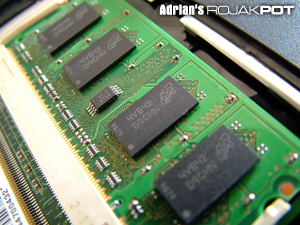Analysing Sonoma
533MHz Front Side Bus
This is one of the key features that Intel is stressing on for the new Sonoma Mobile Technology. The 533MHz Front Side Bus brings a clock speed increase of about 33% from the 400MHz FSB of the Banias platform. So, what does this new 533MHz means?
First of all, the Dothan processor will use a lower multiplier when running with a FSB of 533MHz. Generally, this means that the Dothan will be less likely to be bottlenecked by the slower FSB now that it's running at 533MHz, instead of just 400MHz. This results in improved performance of the Dothan processor even at the same processor clock speed.
Next, the front side bus and memory modules can now run synchronously at 133MHz - the front side bus being a quad-pumped 133MHz bus while the memory modules are running at 133MHz at double data rate. Previously on the Intel 855 chipset, the front side bus only ran with a 400MHz (quad-pumped 100MHz) while the memory modules operate at 333MHz (166MHz x 2) via a clock divider. That meant that both the processor and the RAM could not run synchronously. Operating at asynchronous speeds introduces certain latencies between the processor and memory.
But of course, using the faster PC2700 with the Sonoma platform will inevitably result in asynchronous operation as well. The good news is that at least there's less of a discrepancy between the front side bus speed and the memory speed.
However, the 533MHz front side bus speed does not only bring the benefit of running the processor and memory synchronously, it also brings us to the next feature of Sonoma - the DDR2 memory interface.
The DDR2 Memory Interface
One of the key benefits of utilising DDR2 memory on the Sonoma Mobile Technology platform is its ability to operate at high speeds while maintaining a lower power profile. It achieves this by being able to run at 1.8 volts, as opposed to 2.5 volts used by conventional DDR memory.
Also, by using the FBGA (Fine Ball Grid Array) method of packaging, the DDR memory modules have higher memory densities which results in considerably smaller chips and better thermal and electrical properties. This perfectly fits into the design requirements of a mobile PC that always prefers components with lower power requirements and lower thermal output.
Apart from reducing its power and thermal specifications, the output buffers in DDR2 modules prefetch 4n-bits of data, instead of just 2n-bits in DDR modules. This allows manufacturers to reduce the core speed by half to create a DDR2 module that runs at the same speed as a standard DDR module.
For example, the DRAM core of a 400MHz DDR module runs at 200MHz but in a DDR2 module, the DRAM core actually runs at just 100MHz! Needless to say, DDR2 allows manufacturers to ramp up clock speeds without developing even faster DRAM cores. This capability also shows how DDR2 chips can run with much lower power requirements.
So, what does all this mean for the Sonoma Mobile Technology platform? Comparing to the Banias platform that supports up to PC2700 DDR SDRAM on the Intel 855 chipset family, the Intel® 915 Express chipset now offers support for PC2-3200 and PC2-4300 DDR2 memory!
Comparing the fastest of the Banias platform and the Sonoma platform, that's an improvement of roughly 60% in terms of theoretical peak memory bandwidth. Without doubt, a Sonoma-based mobile PC should performe faster than a Banias-based mobile PC.







 Add to Reddit
Add to Reddit

